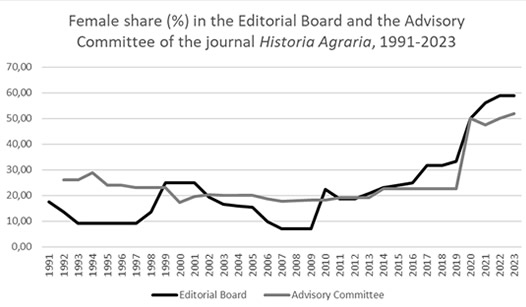EDITORIAL POLICY_Policies on gender
Historia Agraria Policies on Gender
Historia Agraria expressly and publicly adopts an affirmative editorial policy aimed at eliminating gender inequality in its editorial processes. To that end, it adopts a commitment to parity in the composition of its management bodies and in the selection of its external peer reviewers. It also undertakes to promote the visibility of research carried out by women by encouraging the publication of quality articles and the review of relevant books by female authors, and commits to the use of inclusive and neutral language. In this manner, it hopes to contribute to overcoming the structural obstacles that limit women’s participation in the production and dissemination of knowledge.
The first step taken by the journal has been to ensure the equal composition of its editorial bodies, the Editorial Board and the External Advisory Committee (see graph).

The editors have further agreed upon a series of actions to correct gender imbalances in other aspects of the editorial process. Outcomes of those actions will be reflected in the future using the selected indicators (see table).
Indicators of the gender gap in Historia Agraria's editorial processes
| Year | S | P | AS | AP | RF-RM | PR | BR | BA |
|---|---|---|---|---|---|---|---|---|
2022 |
20 |
28 |
25 |
30 |
47 |
30 |
42 |
|
2021 |
38 |
32 |
31 |
50 |
-15 |
43 |
36 |
29 |
2020 |
34 |
33 |
36 |
35 |
14.6 |
57 |
20 |
24 |
2019 |
26 |
24 |
37 |
24 |
2 |
26 |
18 |
16 |
2018 |
42 |
21 |
43 |
33 |
1.6 |
20 |
40 |
22 |
2017 |
31 |
19 |
28 |
16 |
15.6 |
31 |
11 |
10 |
2016 |
26 |
23 |
36 |
23 |
8.5 |
16 |
27 |
24 |
2015 |
25 |
32 |
20 |
39 |
10.7 |
18 |
26 |
37 |
Indicators:
S: percentage of female authors among all article submissions.
P: percentage of female authors among all published authors.
AS: percentage of article submissions for which a woman is the sole author, first author, or one of two authors.
AP: percentage of articles published for which a woman is the sole author, first author, or one of two authors.
RF-RM: difference between the rejection rates for women (RF) and men (RM) (%).
PR: percentage of female peer reviewers.
BR: percentage of female book review authors.
BA: percentage of female authors of reviewed books.